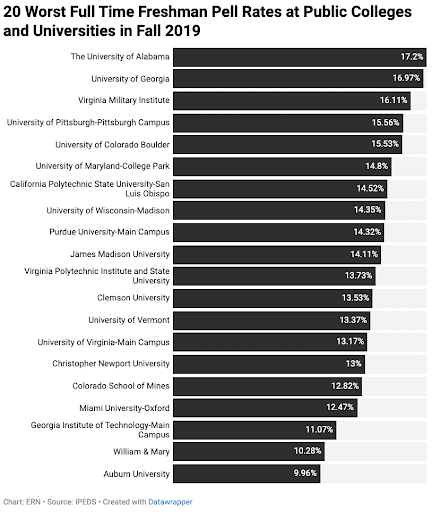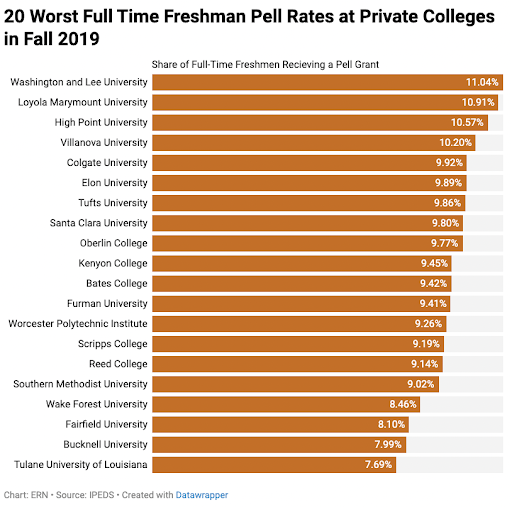Halloween is right around the corner, so in the spirit of the season we wanted to highlight something really scary. Forget ghosts and goblins. If you want to see something really frightening, look at the share of freshmen with Pell Grants enrolled at colleges Tulane University, Bucknell University, Auburn University, and William & Mary University. According to recently released data from the Department of Education, those were the two worst private and two worst public universities in the nation when it came to enrolling low-income and working-class freshmen in fall 2019, even though they each had endowments worth over $750 million in 2020. Tulane’s was worth $1.45 billion.
Ninety percent of Pell Grant recipients come from households with incomes less than $50,000.
To see just how horrifying these Pell rates are, we analyzed 1,585 four year colleges and universities that enrolled at least 100 freshmen in 2019. Here’s how the group looks:
- 35.1% of the freshmen in the whole group received a Pell Grant.
- The average, unweighted institutional Pell share was 40.3%.
- The median Pell share was 38.7%.
Compare those percentages to the 20 worst colleges and universities when it comes to enrolling students with Pell Grants (see figure 1). The orange bars in the chart represent private colleges and universities, while the black bars represent public ones.

A few institutions deserve special Halloween prizes.

- Arthouse Horror Award: Bucknell had the worst Pell share of any liberal arts institution in the nation.
- Frankenstein Award: Worcester Polytechnic Institute had the worst Pell share of any STEM institution in the United States.
- The Purge Award: Reed College’s Pell share declined by 11 percentage points, or 55 percent, from 2013, when 20 percent of its freshmen had a Pell Grant.
- The Pet Sematary Award: Auburn University is the home of the Tigers and the lowest Pell share of any public college or university.
Auburn is not the only public college or university that fails to enroll low-income and working-class students, of course. The Commonwealth of Virginia stands out for having six institutions in the bottom twenty public colleges and universities and four in the bottom ten.

The worst of the worst, however, the truly terrifying colleges and universities where not even one-tenth of the Freshman class received a Pell Grant, are almost exclusively private institutions–private institutions that pay no taxes, benefit from local infrastructure, and receive federal and state financial aid dollars as well as other forms of revenue that ultimately come from taxpayers.

Although we are having some fun with this Halloween theme, the failures of the colleges highlighted here are very serious. Most of the colleges who made our list have two things in common: large endowments and high graduation rates. While some of that graduation rate is attributable to the fact that they enroll wealthier students, it is also likely that they spend a great deal more on supporting the students they enroll. Increasing their Pell shares to 20 percent of their freshman classes could have a transformative effect on students’ lives.
The fact that these rates were so low the year before COVID-19 hit is alarming. The pandemic disproportionately hurt low-income students, even as many wealthier colleges and universities got wealthier due to massive returns on their endowments. Tulane’s endowment, for instance, earned a 30% return in the past year.
Bountiful resources and shame doesn’t seem to be enough to push these “engines of inequality” to serve a greater percentage of the tens of thousands of academically talented, working class and low-income students pursuing higher education at other schools. That is why we support Sen. Chris Coons (D-DE) & Jacky Rosen’s (D-NV) legislation that would create a financial incentive for super wealthy colleges to serve a minimum level of working class and low-income students or contribute a public service fee to under resourced, struggling four-year colleges – like many HBCUs – that are serving those students. And it is why we are urging students and alumni of those schools to participate in a #LeaveYourLegacy campaign that would link future donations to their schools’ actions in furtherance of a genuine commitment to diversity and socioeconomic opportunity.
Check out THIS table to see how your current college or your alma mater does when it comes to making a meaningful commitment to diversity.